
Swallow the Sun Reflect On "20 Years of Gloom, Beauty, and Despair" in Latest Live Album (Interview)
It’s a little unexpected that a 20-year career retrospective could be an optimal entry point for new fans, but Swallow the Sun’s newest live album is one such case. 20 Years of Gloom. Beauty, and Despair – Live in Helsinki is a commemoration of nearly everything they’ve released. Recorded prior to the global shutdown in early 2020, the double live album’s first disc is a string-backed acoustic performance of their largest sonic departure, Songs from the North II: Beauty, while the second is a pseudo greatest hits compilation of tracks their fans selected via an online poll. As such, Swallow the Sun have assembled a chronicle that rewards long-term fans for their investment.
Furthermore, 20 Years of Gloom. Beauty, and Despair – Live in Helsinki is a fantastic primer for newcomers. The sorrow-as-a-celebration congeals all of Swallow the Sun’s facets, from their sullen folk ventures to their ominous funeral doom metal.
Bands usually amplify their rambunctiousness on live recordings, feeding into the audience’s adrenaline. Swallow the Sun subvert this expectation by doubling down on their melancholy. Their dourness is all-encompassing, bolstered by Helsinki’s Tavastia Club’s acoustics, but it’s never suffocating. Swallow the Sun’s brand of death/doom metal is, even at its most catatonic, comforting. They don’t display man’s depravity as much as they reflect and lament humanistic failures. Mourning is Swallow the Sun’s bread and butter, best captured on the aching “Cathedral Walls.”
20 Years of Gloom. Beauty, and Despair – Live in Helsinki’s most striking quality is how the live performance congeals their discography. Their earlier works’ darker tracks stand alongside newer cuts from When a Shadow Is Forced into the Light, which emphasized cleaner vocals. Small tonal differences between albums are amalgamated into a singular portrait of the band’s entire catalog. There’s a benefit in understanding the context behind every track, but the outstanding production binds them together in that such lore isn’t necessary.
Embellishing this cohesiveness is the double album format, arranging the heavier tracks together while giving the folkier, progressive numbers their own disc. Normally such schisms result in undercooked compositions as artists focus on the aesthetics of each sound without examining what made them intriguing. However, as this is a recollection of tracks, 20 Years of Gloom. Beauty, and Despair – Live in Helsinki doesn’t suffer from being drawn too thin.
In fact, there’s a benefit in that both discs explore two sides of the same emotional coin. Of course, the first disc is more sentimental and the second more punishing, but each disc reflects different aspects of the group’s gothic inclinations. Thus, by grouping similar tracks together, Swallow the Sun brandish how their songwriting has progressed through their career. New fans could easily be misled into believing “Lost and Catatonic” and “Empires of Loneliness” were from two different eras, as the former brandishes the group’s strong vocal melodies while the latter is a monolithic death/doom metal curtain, drawn over any rays of sunlight.
20 Years of Gloom. Beauty, and Despair – Live in Helsinki is Swallow the Sun’s well-deserved anniversary. They reward long-time listeners as well as invite newcomers to the funeral processions. Guitarist Juho Räihä was kind enough to answer some of our questions regarding the band’s legacy, their musical duality, and what the fan interactions leading up to the album meant for him. Read the entire conversation below.
…
…
How surprised were you at the songs the fans selected to be on the album?
Not really that surprised. In the live context, the more melodic songs usually work great for us and that seems to be what our fans like too at shows.
“Stone Wings” and “Here on the Black Earth” were both from When a Shadow Is Forced into the Light, an intensely personal album for you about loss. How did you react to seeing those songs grow to be so popular with your fans given their heavy personal toll on you?
Music is an emotional language. It only makes sense that people can relate to the feelings we portray. We all have lost in life, love, and family. It’s a big part of being human. Music can be an integral part of dealing with all emotions, and I think people appreciate it when someone is composing from an honest place, no matter what the emotion is.
You guys originally formed just for one demo tape. Does revisiting these older tracks put them in a new perspective for you or does it put you back in the shoes of who you were when you wrote/recorded them?
I can only comment on this from a bit of an outside perspective since I joined the band in 2018. But for me at least, the older songs are a gateway to a younger version of myself. I have changed a lot during the past decade, but I can still quite vividly get into the headspace of the younger, more energetic, and angsty me. Nothing does it better than moshing and riffing some older StS stuff. It is quite extraordinary how music can take you to different places and times in your life.
Many of the tracks on the album are from the second, folkier disc of Songs from the North, even though that album isn’t your typical death-doom metal affair. What qualities have fans attributed to those songs that make you think they were so popular live?
The acoustic set on the album is definitely a breath of fresh air. We love mixing it up and playing all different kinds of Swallow the Sun stuff live. To us, it feels kind of limiting to call us a straight-up metal band, and we love to be able to show the different sides of Swallow the Sun. We are greatly influenced by all kinds of music and to me, that is one of our biggest strengths.
Have any of these songs taken on new meanings for you?
The songs are always changing shape as you keep changing as a person. To me personally, it feels good now that I have come to full grips with what the songs feel like to me. It’s a never ending road towards being able to put one’s emotions into the playing 100%. “Songs From the North” is a magical song and that is probably the one that keeps shedding its skin the most for me.
How did the songs the fans picked match up with your band’s self-image? Do they represent where you want to go with the band in the future?
I think the songs represented us quite nicely. Although our extremities go much further both in the Metal and the mellower side. But again I fully understand that live is live, and different songs work well in that context as opposed to listening to the albums alone at home.
The album is split into two halves, one showing your folker intuitions and one displaying the band’s heavier sides. Why create this schism, similar to the one you did on Songs from the North?
To show two different sides of the band. And of course, Swallow the Sun has never settled for less than the best we can do. A double album gives more to the fans. We hope that this way everyone can enjoy the release more and for longer.
The new live mixes sound phenomenal. They add gorgeous dynamics to the pieces. How do you feel the string quartet affected the themes of loss in your music?
Thank you. I mixed the heavier set and Jaani Peuhu mixed the acoustic set. I too feel that we managed to capture the mood of the show without being too rough on the edges, like many live albums tend to be. The string section was phenomenal to play with. There is something to be said for the delivery of emotion with those kinds of instruments. Hopefully, we’ll get to play more shows with live strings.
Did the extra time the pandemic afforded you to put into 20 Years Of Gloom, Beauty And Despair – Live in Helsinki, as well as the string quartet, influence your direction on Moonflowers?
The string quartet definitely has come to stay as a part of Swallow the Sun. Can’t think of a much more fitting sound to layer with the heavier feel of us as a band. As per the pandemic, it’s really hard to say. I would like to think that it didn’t influence us too much. We pretty much planned the recordings as if there were no extra pressures or difficulties. Even the hopping between Fascination Street in Sweden and my studio in Finland went surprisingly easy.
…20 Years of Gloom. Beauty, and Despair released July 30th on Century Media Records.










